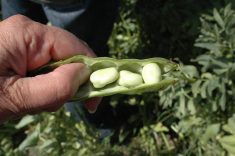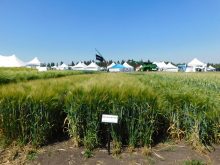Choice The choice of seeding rate is an important decision for corn producers, but no single rate is best
Seeding rate and row spacing are key factors in the response of irrigated corn silage, according to a new study.
The three-year study, which looked at irrigated corn silage production in southern Alberta, found that, on average, 84 per cent of seeds produced a plant. But plant establishment was 12 per cent higher in narrow (38-centimetre) than wide (76-centimetre) rows. Row spacing did not significantly affect yield, but maximum profitability was attained with a lower seeding rate for narrow rows, concluded the study, authored by Brian Beres of Agriculture and Agri-Food Canada, E. Bremer with Symbio Ag Consulting, and Corny Van Dasselaar with Country Commodities.
Read Also

New crop insurer policy enables easier startup for faba beans
Agriculture Financial Services Corporation updated its normals for faba beans, which may open the door for more Canadian producers to feel comfortable growing the pulse crop in the future.
The study also found whole-plant dry matter yields and net income increased by 13 per cent when seeding rates were increased from 64,000 to 74,000 seeds per hectare, but were not significantly affected by seeding rates from 74,000 to 114,000 seeds per hectare.
However, the ideal seeding rate within this range may vary due to site-specific conditions. Producers growing irrigated corn for silage in southern Alberta will maximize profitability at seeding rates ranging from 74,000 to 114,000 seeds per hectare, the study stated.
The choice of seeding rate is an important decision for corn producers, but no single rate is best for all situations because the optimum rate varies with hybrid type, environmental conditions, and agronomic practices. Optimum seeding rates are higher for modern hybrids than older ones, short-season hybrids than long-season ones, irrigated systems than dryland ones, and corn harvested as silage versus corn harvested as grain. Studies conducted in southern Ontario found maximum whole-plant corn yields could be achieved at a plant density of 63,000 plants per hectare. Other studies in Ontario have observed a positive yield response with plant densities as high as 100,000 plants per hectare and with a narrower row spacing.
In southern Alberta, corn receives more crop heat units than in the central part of the province, and may have a lower optimum seeding rate, but is also irrigated, and thus may have a higher optimum seeding rate. Corn is grown in both 38-centimetre and 76-centimetre rows in this region.
The objective of this study was to quantify the optimum seeding rate for irrigated corn silage in southern Alberta, and to determine if row width influences forage yield and quality.
A current hybrid with high yield potential and a maximum corn heat unit rating for the region was selected for this study. A John Deere 71 Flexi-Planter was calibrated to each seed rate using interchangeable plates. Row width was set by changing the position of the opener assembly on the tool bar of the planter. Plant densities were monitored by counting plants within six 1.8-metre row segments in each plot after complete emergence. Plots were harvested with a commercial harvester, either a Klaas 900 or John Deere 7050 self-propelled forage harvester. Harvested material was weighed with feed trucks.














